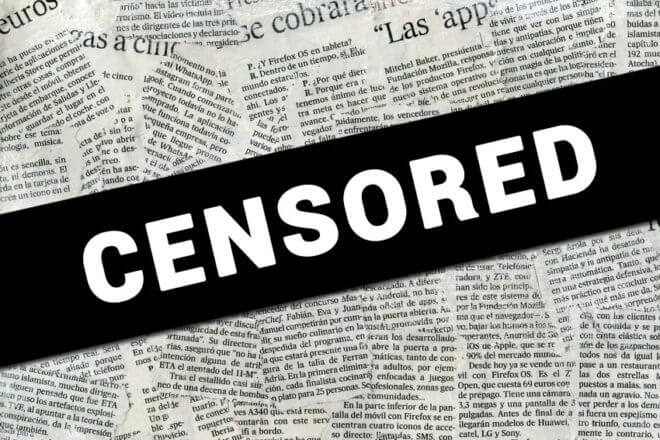This article has been written by Vinay Shettigar, pursuing a Diploma in US Intellectual Property Law and Paralegal Studies from LawSikho.
It has been published by Rachit Garg.
Table of Contents
Introduction
Imagine living in a country where your freedom of speech is constantly under threat. Where expressing your opinions and thoughts can land you in jail, welcome to India’s censorship regime, where censorship laws and regulations have come under fire for their potential to violate human rights. But what can be done to strike a balance between protecting freedom of speech and expression while also ensuring that the public is not exposed to harmful or offensive content?
This article has it all covered. Let’s begin!
The historical context of censorship in India
Censorship in India has a long and complex history, with laws and regulations dating back to colonial times. During British rule, censorship laws were primarily used to control political dissent and maintain the power of the colonial government. The Indian Government inherited these laws after independence in 1947. Over the years, censorship laws in India have developed to include novel forms of media, such as films and social media, but the basic principle remains the same: to control the flow of information and protect the government from criticism. One of the most controversial censorship laws in India’s history is the Cinematograph Act, 1952. This law gave the government the power to censor films before they were released to the public, and it was frequently used to censor films that were deemed politically or socially unacceptable. For example, the Indian Government banned the screening of Richard Attenborough’s 1982 film “Gandhi,” which depicted the life of the Indian independence leader, for over a decade, citing the film’s depiction of the prime minister as inaccurate.
In recent years, censorship has been increasingly used to control the narrative on the internet and social media. In December 2020, the Indian Government banned the BBC documentary “India’s Republic at 71,” which was critical of the current Prime Minister Modi. The Government claimed that the documentary was spreading misinformation and promoting anti-India sentiment. The international community and human rights organisations widely criticised this move for violating freedom of speech and expression.
Besides censorship laws, India also has several laws and regulations that can restrict freedom of speech and expression, such as the Indian Penal Code, 1860, and the Information Technology Act, 2000. These laws have been used to silence critics of the government, journalists, and human rights activists.
Overall, censorship in India has been used throughout history to control the flow of information and maintain the power of the government. It has evolved into new forms of media, but the basic principle remains the same. The recent banning of a BBC documentary on Prime Minister Modi exemplifies how censorship laws are being used to silence critics and maintain the government’s narrative.
How does censorship work in India : a brief overview
In India, censorship is directly and indirectly governed by different legislations, namely:
- The Indian Penal Code, 1860;
- The Code of Criminal Procedure, 1973;
- The Press Council of India Act, 1978;
- The Cinematograph Act, 1952;
- The Cable Television (Regulation) Act, 1995, etc.
Further, there are several authorities that exercise censorship in India, namely:
- The Central Bureau of Film Certification (CBFC),
- The Press Council of India.
The current state of censorship in India
Censorship in India continues to be a contentious issue in the present day. The government still wields significant power to control the flow of information through censorship laws and regulations. One of the most notable examples of censorship in practice is the Central Board of Film Certification (CBFC), which has the power to censor films before they are released to the public. This power has been used to censor films that are deemed politically or socially unacceptable, such as the film “Padmavat,” which depicted a romantic relationship between a Hindu queen and a Muslim king.
Another area where censorship is prevalent is social media. The government has the power to block or remove content that it deems offensive or a threat to national security. This has led to frequent censorship of content that is criticised by the government or is against government policies. Social media platforms, such as Twitter and Facebook, have also been known to comply with government requests to remove content or suspend accounts.
The impact of censorship on freedom of speech and expression in India is significant. Censorship laws and regulations are often used to silence critics of the government, journalists, and human rights activists. This has a chilling effect on free speech and can lead to self-censorship. It also limits the public’s ability to access a diverse range of opinions and information, which is essential for a healthy democracy.
In addition, censorship laws and regulations are often ambiguous and inconsistent, making it difficult for individuals and organisations to know what is and is not allowed. This can lead to confusion and uncertainty and be used by the government to silence critics and control the narrative.
Overall, censorship in India continues to be a significant issue in the present day. The government still wields significant power to control the flow of information through censorship laws and regulations, and this has a significant impact on freedom of speech and expression in the country.
Analysis of the censorship regime in India
The censorship regime in India has come under criticism for its potential to violate human rights, including the right to freedom of speech and expression. One of the main concerns is the wide discretion given to the government to censor content that it deems offensive or a threat to national security. This has led to frequent censorship of content that is criticised by the government or is against government policies, which can have a chilling effect on free speech and lead to self-censorship.
Additionally, there are inconsistencies and ambiguities in the censorship laws and regulations in India. This makes it difficult for individuals and organisations to know what is and is not allowed and can lead to confusion and uncertainty. The government can also use this to silence critics and control the narrative.
Furthermore, censorship laws and regulations are not always in line with international human rights standards. For example, the Indian Penal Code, 1860, criminalises speech crimes, which can have a chilling effect on free speech. And with the recent banning of a BBC documentary on Indian PM Modi, the government’s actions have been criticised for being politically motivated rather than based on any real threat to national security.
In summary, the censorship regime in India has come under criticism for its potential to violate human rights, including the right to freedom of speech and expression. Also, there is a lack of harmony and a lot of ambiguities in the censorship laws and regulations, and they are not always in line with international human rights standards. Therefore, it is important that changes are made to ensure that freedom of speech and expression is protected in India.
Suggested changes to India’s censorship regime
The current state of censorship in India is problematic, and it is important that changes are made to ensure that freedom of speech and expression is protected. Here are a few suggested changes that could be made to India’s censorship regime:
Review and reform censorship laws
The existing censorship laws in India are outdated and often ambiguous. A review and reform of these laws are needed to ensure that they are consistent, clear, and in line with international human rights standards.
Decriminalise speech offences
India’s laws on speech offences should be reviewed and reformed to ensure that they do not criminalise speech offences, which can have a chilling effect on free speech.
Increase transparency and accountability
The government should be more transparent and accountable in its use of censorship laws and regulations. This includes providing clear guidelines on what is and is not allowed, as well as publishing data on the number of censorship requests it receives and how they are handled.
Establish an independent body to review censorship decisions
An independent body should be established to review censorship decisions made by the government. This body should be made up of experts in human rights, media, and other relevant fields, and should have the power to overturn censorship decisions made by the government.
Promote digital and media literacy
India’s censorship regime is heavily focused on the internet and social media. To ensure that citizens can navigate this complex environment and make informed decisions, it is important to promote digital literacy and media literacy.
Overall, suggested changes to India’s censorship regime would ensure that freedom of speech and expression is protected and that censorship laws and regulations are clear, consistent, and in line with international human rights standards. It would also increase the transparency and accountability of the government, promote digital and media literacy among citizens, and establish an independent body to review censorship decisions.
Future outlook on censorship in India
There are several suggested changes that can be made to India’s censorship regime to ensure that it is in line with international human rights standards and that it strikes a balance between protecting freedom of speech and expression and protecting the public. These include reviewing and reforming censorship laws, decriminalising speech offences, increasing transparency and accountability, establishing an independent body to review censorship decisions, and promoting digital and media literacy.
To ensure that censorship laws and regulations are effective, it is important to involve a wide range of stakeholders in the process, including human rights organisations, media representatives, and members of the public. With a collaborative and inclusive approach, India can develop a censorship regime that strikes a balance between protecting freedom of speech and expression and protecting the public.
Conclusion
In conclusion, India’s censorship regime has come under criticism for its potential to violate human rights, including the right to freedom of speech and expression. The wide discretion given to the government to censor content has led to frequent censorship of content criticised by the government or against government policies, which can have a chilling effect on free speech and lead to self-censorship. Additionally, there are inconsistencies and ambiguities in the censorship laws and regulations, making it difficult for individuals and organisations to know what is and is not allowed.
However, it is important to note that censorship laws and regulations are put in place to protect the public from harmful or offensive content. Therefore, it is crucial to strike a balance between protecting freedom of speech and expression while also ensuring that the public is not exposed to harmful or offensive content.
References
- https://www.law.du.edu/documents/sports-and-entertainment-law-journal/issues/07/right.pdf
- https://cis-india.org/internet-governance/blog/india-digital-freedoms-3-censorship
- https://www.medianama.com/2021/06/223-legality-constitutionality-of-it-rules/
- https://www.thehindu.com/news/national/is-the-freedom-of-speech-absolute/article38053468.ece
- https://clpr.org.in/blog/a-little-over-the-top-examining-indias-new-laws-for-online-speech-part-i/
- https://www.amnesty.org/enj/latest/news/2022/05/india-supreme-courts-temporary-suspension-of-sedition-law-a-welcome-step/
- https://www.icj.org/punished-for-protest-indias-violations-against-human-rights-defenders/
- https://www.ijlmh.com/wp-content/uploads/2019/05/A-SOCIO-LEGAL-PERSPECTIVE-OF-THE-CINEMATOGRAPH-ACT-1952.pdf
Students of Lawsikho courses regularly produce writing assignments and work on practical exercises as a part of their coursework and develop themselves in real-life practical skills.
LawSikho has created a telegram group for exchanging legal knowledge, referrals, and various opportunities. You can click on this link and join:
Follow us on Instagram and subscribe to our YouTube channel for more amazing legal content.
 Serato DJ Crack 2025Serato DJ PRO Crack
Serato DJ Crack 2025Serato DJ PRO Crack











 Allow notifications
Allow notifications



